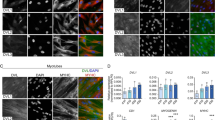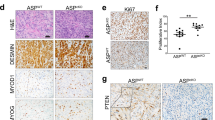Abstract
Alveolar rhabdomyosarcomas (ARMS) escape terminal differentiation despite exhibiting a skeletal muscle phenotype. To understand the role of the ARMS-specific PAX-FKHR proteins in myogenesis, we characterized their regulation of MyoD expression and function. Reporter assays show that PAX-FKHR transactivate MyoD expression through its 258 bp core enhancer. Gel-shift assays confirm that PAX-FKHR bind to core enhancer sequences showing similarity to consensus PAX3/PAX-FKHR-binding sites. We show that while PAX3-FKHR activates the expression of endogenous MyoD and myogenin proteins in transduced NIH3T3 fibroblasts, it inhibits them from terminally differentiating as shown by low myogenin and myosin heavy chain expression, and lack of myotube formation. Attenuation of MyoD transcriptional activity via phosphorylation coupled to the lack of cell cycle arrest is the underlying mechanism for the differentiation block. Lastly, we show that fibroblast growth factor receptor signaling likely mediates the inhibition of differentiation by PAX3-FKHR. In a single experimental system we demonstrate that PAX3-FKHR can simultaneously induce myogenesis while preventing its completion. We propose a model whereby PAX-FKHR commit a yet undefined precursor cell to the myogenic lineage while at the same time inhibit terminal differentiation, thereby contributing to ARMS formation.
This is a preview of subscription content, access via your institution
Access options
Subscribe to this journal
Receive 50 print issues and online access
$259.00 per year
only $5.18 per issue
Buy this article
- Purchase on Springer Link
- Instant access to full article PDF
Prices may be subject to local taxes which are calculated during checkout









Similar content being viewed by others
References
Anderson J, Ramsay A, Gould S, Pritchard-Jones K . (2001a). PAX3-FKHR induces morphological change and enhances cellular proliferation and invasion in rhabdomyosarcoma. Am J Pathol 159: 1089–1096.
Anderson MJ, Shelton GD, Cavenee WK, Arden KC . (2001b). Embryonic expression of the tumor-associated PAX3-FKHR fusion protein interferes with the developmental functions of Pax3. Proc Natl Acad Sci USA 98: 1589–1594.
Barr FG . (2001). Gene fusions involving PAX and FOX family members in alveolar rhabdomyosarcoma. Oncogene 20: 5736–5746.
Bernasconi M, Remppis A, Fredericks WJ, Rauscher III FJ, Schafer BW . (1996). Induction of apoptosis in rhabdomyosarcoma cells through down-regulation of PAX proteins. Proc Natl Acad Sci USA 93: 13164–13169.
Chalepakis G, Fritsch R, Fickenscher H, Deutsch U, Goulding M, Gruss P . (1991). The molecular basis of the undulated/Pax-1 mutation. Cell 66: 873–884.
Davicioni E, Finckenstein FG, Shahbazian V, Buckley JD, Triche TJ, Anderson MJ . (2006). Identification of a PAX-FKHR gene expression signature that defines molecular classes and determines the prognosis of alveolar rhabdomyosarcomas. Cancer Res 66: 6936–6946.
Davis RJ, Barr FG . (1997). Fusion genes resulting from alternative chromosomal translocations are overexpressed by gene-specific mechanisms in alveolar rhabdomyosarcoma. Proc Natl Acad Sci USA 94: 8047–8051.
Davis RL, Weintraub H, Lassar AB . (1987). Expression of a single transfected cDNA converts fibroblasts to myoblasts. Cell 51: 987–1000.
Epstein JA, Lam P, Jepeal L, Maas RL, Shapiro DN . (1995). Pax3 inhibits myogenic differentiation of cultured myoblast cells. J Biol Chem 270: 11719–11722.
Epstein JA, Song B, Lakkis M, Wang C . (1998). Tumor-specific PAX3-FKHR transcription factor, but not PAX3, activates the platelet-derived growth factor alpha receptor. Mol Cell Biol 18: 4118–4130.
Fredericks WJ, Galili N, Mukhopadhyay S, Rovera G, Bennicelli J, Barr FG et al. (1995). The PAX3-FKHR fusion protein created by the t(2;13) translocation in alveolar rhabdomyosarcomas is a more potent transcriptional activator than PAX3. Mol Cell Biol 15: 1522–1535.
Goldhamer DJ, Brunk BP, Faerman A, King A, Shani M, Emerson Jr CP . (1995). Embryonic activation of the myoD gene is regulated by a highly conserved distal control element. Development 121: 637–649.
Goldhamer DJ, Faerman A, Shani M, Emerson Jr CP . (1992). Regulatory elements that control the lineage-specific expression of myoD. Science 256: 538–542.
Keller C, Arenkiel BR, Coffin CM, El-Bardeesy N, DePinho RA, Capecchi MR . (2004). Alveolar rhabdomyosarcomas in conditional Pax3:Fkhr mice: cooperativity of Ink4a/ARF and Trp53 loss of function. Genes Dev 18: 2614–2626.
Khan J, Bittner ML, Saal LH, Teichmann U, Azorsa DO, Gooden GC et al. (1999). cDNA microarrays detect activation of a myogenic transcription program by the PAX3-FKHR fusion oncogene. Proc Natl Acad Sci USA 96: 13264–13269.
Lam PY, Sublett JE, Hollenbach AD, Roussel MF . (1999). The oncogenic potential of the Pax3-FKHR fusion protein requires the Pax3 homeodomain recognition helix but not the Pax3 paired-box DNA binding domain. Mol Cell Biol 19: 594–601.
Lang D, Lu MM, Huang L, Engleka KA, Zhang M, Chu EY et al. (2005). Pax3 functions at a nodal point in melanocyte stem cell differentiation. Nature 433: 884–887.
Li L, Zhou J, James G, Heller-Harrison R, Czech MP, Olson EN . (1992). FGF inactivates myogenic helix–loop–helix proteins through phosphorylation of a conserved protein kinase C site in their DNA-binding domains. Cell 71: 1181–1194.
Liu LN, Dias P, Houghton PJ . (1998). Mutation of Thr115 in MyoD positively regulates function in murine fibroblasts and human rhabdomyosarcoma cells. Cell Growth Differ 9: 699–711.
Lu J, McKinsey TA, Zhang CL, Olson EN . (2000). Regulation of skeletal myogenesis by association of the MEF2 transcription factor with class II histone deacetylases. Mol Cell 6: 233–244.
Novitch BG, Mulligan GJ, Jacks T, Lassar AB . (1996). Skeletal muscle cells lacking the retinoblastoma protein display defects in muscle gene expression and accumulate in S and G2 phases of the cell cycle. J Cell Biol 135: 441–456.
Novitch BG, Spicer DB, Kim PS, Cheung WL, Lassar AB . (1999). pRb is required for MEF2-dependent gene expression as well as cell-cycle arrest during skeletal muscle differentiation. Curr Biol 9: 449–459.
Puri PL, Sartorelli V . (2000). Regulation of muscle regulatory factors by DNA-binding, interacting proteins, and post-transcriptional modifications. J Cell Physiol 185: 155–173.
Robson EJ, He SJ, Eccles MR . (2006). A PANorama of PAX genes in cancer and development. Nat Rev Cancer 6: 52–62.
Schmidt D, Reimann O, Treuner J, Harms D . (1986). Cellular differentiation and prognosis in embryonal rhabdomyosarcoma. A report from the Cooperative Soft Tissue Sarcoma Study 1981 (CWS 81). Virchows Arch A Pathol Anat Histopathol 409: 183–194.
Tapscott SJ, Lassar AB, Weintraub H . (1992). A novel myoblast enhancer element mediates MyoD transcription. Mol Cell Biol 12: 4994–5003.
Zhang L, Wang C . (2007). Identification of a new class of PAX3-FKHR target promoters: a role of the Pax3 paired box DNA binding domain. Oncogene 26: 1595–1605.
Acknowledgements
We thank David Goldhamer for MyoD reporter constructs; Martyn Goulding, Eric Olsen, Andrew Lassar, Pier-Luigi Lollini, Helen Blau and Frank Rauscher for reagents; Jocelyn Montalvo and Jerry Barnhart for technical assistance; George McNamara and Shelley Nelson for helpful discussions. This work was supported by a Saban Institute Research Career Development Award (MJA).
Author information
Authors and Affiliations
Corresponding author
Additional information
Supplementary Information accompanies the paper on the Oncogene website (http://www.nature.com/onc).
Supplementary information
Rights and permissions
About this article
Cite this article
Graf Finckenstein, F., Shahbazian, V., Davicioni, E. et al. PAX-FKHR function as pangenes by simultaneously inducing and inhibiting myogenesis. Oncogene 27, 2004–2014 (2008). https://doi.org/10.1038/sj.onc.1210835
Received:
Revised:
Accepted:
Published:
Issue Date:
DOI: https://doi.org/10.1038/sj.onc.1210835
Keywords
This article is cited by
-
Cavin-1 and Caveolin-1 are both required to support cell proliferation, migration and anchorage-independent cell growth in rhabdomyosarcoma
Laboratory Investigation (2015)
-
PAX3-NCOA2 fusion gene has a dual role in promoting the proliferation and inhibiting the myogenic differentiation of rhabdomyosarcoma cells
Oncogene (2014)
-
Alveolar rhabdomyosarcoma-associated proteins PAX3/FOXO1A and PAX7/FOXO1A suppress the transcriptional activity of MyoD-target genes in muscle stem cells
Oncogene (2013)
-
Alternate PAX3 and PAX7 C-terminal isoforms in myogenic differentiation and sarcomagenesis
Clinical and Translational Oncology (2011)
-
Diagnostic and Prognostic Sarcoma Signatures
Molecular Diagnosis & Therapy (2008)



